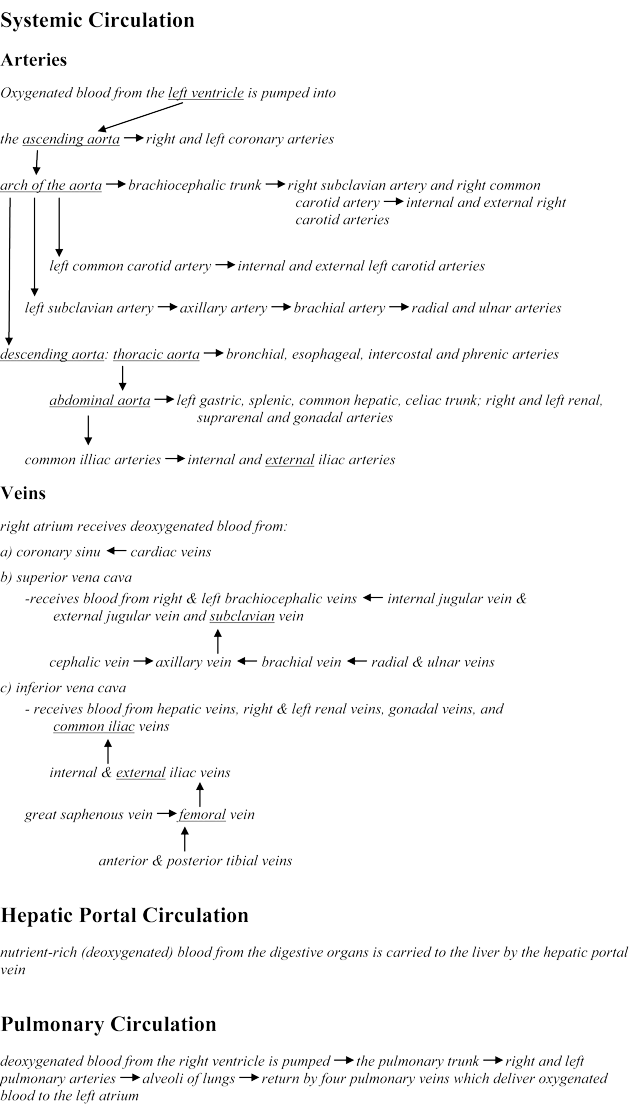Biology 235 Human Anatomy and Physiology
Study Guide
Chapter 21
The Cardiovascular System: Blood Vessels and Hemodynamics
Objectives
After completing this chapter, you should be able to
- compare the structure and function of the arteries, arterioles, capillaries, venules and veins.
- identify, in order, the vessels through which the blood moves in its passage from the heart to the capillaries and back.
- discuss the various pressures involved in the movement of fluids between capillaries and interstitial spaces.
- explain the factors that regulate the volume of blood flow.
- describe how blood pressure is regulated.
- define pulse, systolic pressure, diastolic pressure and pulse pressure.
- describe the four types of shock and their homeostatic responses.
- identify the principal arteries and veins, and describe the flow of blood through the systemic, hepatic portal and pulmonary circulations.
- describe the disorders listed.
Keywords and Topics
Make certain that you can define, and use in context, each of the terms listed below, and that you understand the significance of each of the concepts.
- Compare the structure and function of the arteries, arterioles, capillaries, venules and veins.
- hemodynamics
- structure and function of blood vessels
- tunica interna (intima)
- lumen
- endothelium
- basement membrane
- internal elastic lamina
- tunica media
- vasoconstriction
- vasodilation
- external elastic lamina
- tunica externa
- vasa vasorum
- compliance
- elastic arteries
- elastic lamellae
- pressure reservoir
- muscular arteries
- distributing arteries
- anastomoses
- collateral circulation
- end arteries
- arterioles
- metarteriole
- precapillary sphincters
- resistance
- capillaries
- microcirculation
- capillary bed
- vasomotion
- thoroughfare channel
- continuous capillary
- fenestrated capillary
- sinusoid
- portal system
- venules
- postcapillary venules
- muscular venules
- veins
- valves
- vascular sinus or venous sinus
- anastomotic veins
- superficial veins
- deep veins
- blood reservoirs
- venoconstriction
- Identify, in order, the vessels through which the blood moves in its passage from the heart to the capillaries and back.
- arteries
- arterioles
- capillaries
- venules
- veins
- Discuss the various pressures involved in the movement of fluids between capillaries and interstitial spaces.
- capillary exchange
- diffusion
- transcytosis
- bulk flow
- filtration
- reabsorption
- net filtration pressure (NFP)
- Starling law of the capillaries
- blood hydrostatic pressure (BHP)
- interstitial fluid hydrostatic pressure (IFHP)
- edema
- blood colloid osmotic pressure (BCOP)
- interstitial fluid osmotic pressure (IFOP)
- capillary exchange
- Explain the factors that regulate the volume of blood flow.
- hemodynamics: factors affecting blood flow
- blood flow
- blood pressure
- systolic blood pressure
- diastolic blood pressure
- mean arterial blood pressure (MAP)
- vascular resistance
- size of lumen
- blood viscosity
- total blood vessel length
- systemic vascular resistance (SVR) or total peripheral resistance (TPR)
- venous return
- skeletal muscle pump
- respiratory pump
- velocity of blood flow
- circulation time
- hemodynamics: factors affecting blood flow
- Describe how blood pressure is regulated.
- control of blood pressure and blood flow
- cardiovascular (CV) center
- proprioceptors
- baroreceptors
- chemoreceptors
- cardiac accelerator nerves
- vagus (X) nerves
- vasomotor nerves
- vasomotor tone
- neural regulation of blood pressure
- baroreceptor reflexes
- carotid sinus reflex
- aortic reflex
- chemoreceptor reflexes
- carotid bodies
- aortic bodies
- hormonal regulation of blood pressure
- renin angiotensin aldosterone (RAA) system
- renin
- angiotensin II
- aldosterone
- epinephrine and norepinephrine
- antidiuretic hormone (ADH) or vasopressin
- atrial natriuretic peptide (ANP)
- renin angiotensin aldosterone (RAA) system
- autoregulation of blood pressure
- autoregulation
- myogenic response
- vasodilating and vasoconstricting chemicals
- cardiovascular (CV) center
- control of blood pressure and blood flow
- Define pulse, systolic pressure, diastolic pressure and pulse pressure.
- checking circulation
- pulse
- tachycardia
- bradycardia
- measuring blood pressure
- blood pressure
- sphygmomanometer
- systolic blood pressure (SBP)
- diastolic blood pressure (DBP)
- Korotkoff sounds
- pulse pressure
- checking circulation
- Describe the four types of shock and their homeostatic responses.
- shock and homeostasis
- types of shock
- hypovolemic shock
- cardiogenic shock
- vascular shock
- obstructive shock
- hemostatic responses to shock with the feedback systems
- signs and symptoms of shock
- types of shock
- shock and homeostasis
- Identify the principal arteries and veins, and describe the flow of blood through the systemic, hepatic portal and pulmonary circulations.
- circulatory routes
- systemic circulation
- coronary circulation
- cerebral circulation
- hepatic portal circulation
- pulmonary circulation
- fetal circulation
- systemic circulation
Note: The pathway of blood flow of, and the organs served by, the systemic circulation, hepatic portal circulation and pulmonary circulation are summarized in the flow charts presented below.
- circulatory routes
- Describe the disorders listed.
- hypertension

Complete the “Chapter Review and Resource Summary” at the end of the chapter.
Use the “Practice Questions” and the various “Interactivity” tools found in each eText chapter in WileyPLUS. Working through these activities will test your understanding of the material presented and ensure your notes are complete.

 Chapter 1
Chapter 1